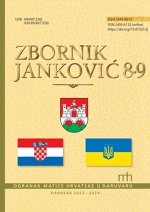Prilog poznavanju procesa naseljavanja i broja pravoslavnog stanovništva u Daruvarskom kraju krajem 17. i tijekom 18. stoljeća
Contribution to the Knowledge of the Process of Colonisation and the Number of Orthodox Population in the Daruvar Area from the End of the 17th and During the 18th Century
Author(s): Hrvoje PetrićSubject(s): Social history, Demography and human biology, 17th Century, 18th Century, Eastern Orthodoxy, Other Christian Denominations
Published by: Matica hrvatska Daruvar
Keywords: Daruvar; demography; colonization; Orthodox population; The Habsburg Monarchy; economy; census;
Summary/Abstract: The article presents selected information on the process of colonisation and total number of orthodox parochies in Daruvar area: Bastaji, Bijela-Borki, Brestovac, Podborje (Daruvar), Doljani, Uljanik, Cjepidlake, Trojeglava, Klisa, Sirač i Grahovljani at the end of the 17th and during the 18th century. After occupation of territory around Stupčanica and Dobra Kuća, the Ottomans, most probably, came upon a few natives. Presumably, soon after the establishment of Ottoman rule on this territory, the process of its colonisation had begun, mostly with Orthodox population starting from Cjepidlaka through Bastaj and Batinjan, i.e. Stupančica and Dobra Kuća, following towards Podborje, Golubinjak and Kričko brdo. The Orthodox Wallachian population became majority so there is no wonder why this territory, inherited from the Habsburgs, became known as The Little Wallachia (Parva Valachia). It seems like that, from the start of colonisation until the end of the 18th century, villages like Vrijeska, Markovac, Pakrani, Bijela, Borki and Bastaji reflect continuity of inhabitants. Some villages were abandoned temporarily like Batinjani from 1682 until 1688, Golubinjak from 1683 until 1688, Cjepidlake from 1684 until 1686 and from 1687 until 1690 Puklica, Potočani and Koreničani. The Orthodoxes left Dobra Kuća, settled back again in 1700. Sređani, Podborje, Doljani, Vrbovac, Karanovci and Miljanovci were populated at the beginning of the 17th century, a few decades later Kip, Šibovac, Grahovljani, Uljanik, Brestovac i Trojeglava, after which the network of populated villages had been framed, in most part able to hold out until today. The formation of this network was accompanied by increase in population so, from the end of the 17th until the end of the 18th century, the number of Orthodox households had risen from 338 to 1 016 in only eight decades. Relatively strong increase occurred at the end of the 17th and the beginning of the 18th century when the colonization process and founding of new villages had begun. Until 1730 the increase was small, until 1750 it accelerated a little only to become most frequent in 1779 when Janković family ruled the manors of Podborje, Daruvar and Sirač along with introduction of agricultural innovations and other modernisation processes. As is worth saying, in this period the climate conditions were most favourable.
Journal: Zbornik Janković
- Issue Year: VII/2024
- Issue No: 8-9
- Page Range: 170-195
- Page Count: 26
- Language: Croatian

